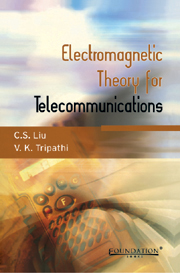Book contents
- Frontmatter
- Contents
- Preface
- 1 Electromagnetic Fields
- 2 Plane Waves
- 3 Guided Waves
- 4 Radiation
- 5 Radio Communication and Radar
- 6 Satellite Communication
- 7 Laser and Optical Fibre Communication
- 8 Geological Seisming and Remote Sensing
- 9 Relativistic Covariance of Electrodynamics
- 10 Radiation from Accelerated Charges
- Appendix A
- Appendix B
- Index
1 - Electromagnetic Fields
Published online by Cambridge University Press: 26 October 2011
- Frontmatter
- Contents
- Preface
- 1 Electromagnetic Fields
- 2 Plane Waves
- 3 Guided Waves
- 4 Radiation
- 5 Radio Communication and Radar
- 6 Satellite Communication
- 7 Laser and Optical Fibre Communication
- 8 Geological Seisming and Remote Sensing
- 9 Relativistic Covariance of Electrodynamics
- 10 Radiation from Accelerated Charges
- Appendix A
- Appendix B
- Index
Summary
Introduction
All the forces that we encounter in nature are manifestations of four forces : (i) gravitational force, arising between bodies by virtue of their masses, (ii) electromagnetic force, arising between bodies by virtue of their charges (stationary and moving), (iii) strong nuclear force, operative at short distances ≤ 10−15 metre, which holds nucleons i.e., protons and neutrons together in a nucleus and (iv) weak nuclear force that accounts for certain kinds of radioactive decay. Of these four, the electromagnetic force appears in the most diverse forms and is encountered very frequently in our daily lives. For example, the push that we give to a block with our hands to make it move, is the electromagnetic force of repulsion between the charged constituents of molecules of our hands and those of the block. A book lying on a table experiences an electromagnetic force between the molecules of the surface of the table and those at the bottom of the book. The upward thrust exerted by a liquid on a body immersed in it (Archimedes principle) is the electromagnetic force between the liquid molecules and those of the body. The force that accounts for the stability of electrons rotating around the nucleus in an atom is again an electric force. The forces that bind the atoms in a solid are also electromagnetic in nature. Elastic forces too are electromagnetic forces. Our physiological functions, such as the beating of the heart and the transmission of neural signals, usually involve electromagnetic processes.
The basic constituents of matter in nature are electrons, protons and neutrons. All the three particles possess mass.
- Type
- Chapter
- Information
- Electromagnetic Theory for Telecommunications , pp. 1 - 46Publisher: Foundation BooksPrint publication year: 2007



